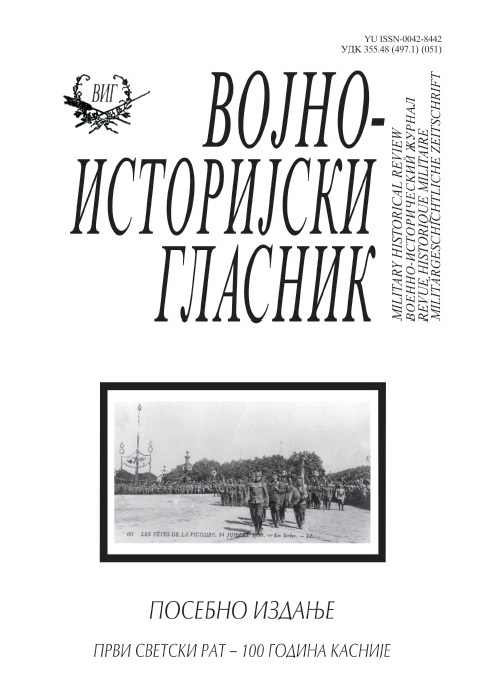СРПСКИ ДОБРОВОЉАЧКИ ПОКРЕТ У ВЕЛИКОМ РАТУ (1914–1918)
SERBIAN VOLUNTEERS MOVEMENT IN THE GREAT WAR (1914–1918)
Author(s): Milan MicićSubject(s): Military history
Published by: Institut za strategijska istraživanja
Keywords: Great war; volunteers; Serbs; Austro‐Hungary; Serbia, Montenegro; Russia; United States of America
Summary/Abstract: Serbian military volunteers in the Great War, in armies of the Kingdom of Serbia and the Kingdom of Montenegro, were citizens of Austro‐Hungary that, by their acts of volunteerism in the First World War (1914‐1918), choose to fight on the side of their national countries. In the eyes of Austro‐Hungary however they were considered traitors and not only death penalty awaited them if they were caught, but also their families where taken to prison camps and their property was confiscated. Serbian volunteers who signed up for Ser‐bian army were led by national ideal of Serbian people. After the Declaration of Naissus on 7th of December 1914, when Serbia proclaimed to fight for the creation of united South Slavic state, the Serbian volunteer movement was more and more presented by Allies governments to the public as the Yugoslav volunteer movement, even though it was almost entirely constituted from Serbs citizens of Austro‐Hungary. Therefore, the Serbian volunteer movement was twofold in its nature, being both political and ideological: Austro‐Hunga‐rian Serbs, by the act of war volunteerism, spoke out their desire to unite with the Kingdom of Serbia; on the other hand, relatively few of Croats and Sloveni‐ans that joined the Serbian volunteer ranks represented the broader Yugoslav ideal of unification. At the same time, this Serbian volunteer movement reflec‐ted the relations between Serbia and Montenegro, especially after the capitu‐lation of Montenegro in 1916, thus becoming the instrument of Serbian go‐vernment for uniting of Montenegro, Boka Kotorska and Herzegovina with Serbia. The main sources of volunteers signing up for Serbian and Montenegrin army in 1914, were territories temporary entered by armies of Serbia and ar‐mies of Montenegro: East Bosnia, East Herzegovina, Srem, parts of Boka Ko‐torska and also Serbs citizens of Austro‐Hungary prisoners of war captured during the fights in 1914, Serbs Austro‐Hungary soldiers captured in Russia in the period 1914‐1916, Serbian prisoners of war in Italy, and Serbs who went from Austro‐Hungary to work in United Stated of America. Serbian government treated the question of volunteer movement as marginal, at the same time being careful not to violate the international war laws. On the other hand, it worried that the overflow of war volunteers will empower the national‐revolutionary organization „Unification or Death” which claimed control over chetnik unites in 1914, and Volunteer movement in 1915‐1916. After the occupation of Serbia in year 1915, the only and the last source of military recruits and manpower were the Serbs volunteers, citizens of Austro‐Hungary. In the year 1916, the First Serbian Volunteer Division was formed on Russian soil, and it went to fight in Dobruja battlefield as a part of Romano‐ Russian troops. This division was later known as the Serbian Volunteer Corps or Volunteer Corps of Serbs, Croats and Slovenians. Due to several issues like heavy losses in the battle of Dobruja in autumn 1916, reflection of Serbian‐ Croatian relations regarding the Yugoslav question and revolutionary activity in Russia, the Volunteer movement found itself in perpetual crisis after autumn 1916. The first and the second Yugoslav regiment of the Yugoslav Di‐ vision were constituted from volunteers that came from Russia to fight at Sa‐lonika front after the crisis of the movement in 1917‐1918. The arrival of volunteers from the United States into Serbian army was a coordinated action take by Serbian government with a help of Allies (France in the first place and then United Kingdom and United States) that gave mas‐ sive political, diplomatic, material and military support in order to empower Serbian army at Salonika front. The gathering of Serbian volunteer in USA re‐ flected the conflicts within the Serbian community and the relations between Serbian and Croatian labor emigrates, showing that the Croats were more in‐ clined towards Austro‐Hungary.
Journal: Vojnoistorijski glasnik
- Issue Year: 2019
- Issue No: poseban
- Page Range: 112-141
- Page Count: 30
- Language: Serbian

